'Porter's Five Forces' Analysis for Banking Industry of Australia
Added on 2022-09-08
24 Pages5554 Words76 Views
Running head: ORGANISATIONAL STRATEGY
'Porter's Five Forces' analysis for Banking Industry of Australia
Name of the Student:
Name of the University:
Author note:
'Porter's Five Forces' analysis for Banking Industry of Australia
Name of the Student:
Name of the University:
Author note:
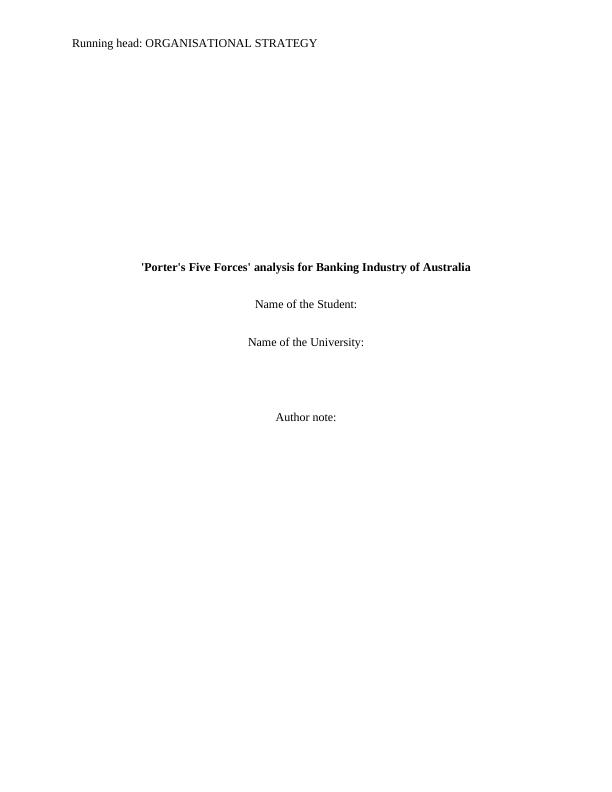
1
ORGANISATIONAL STRATEGY
Table of Contents
1.0 Introduction................................................................................................................................2
2.0 Environment analysis of banking industry and profitability.....................................................3
2.1 Porter’s five forces.................................................................................................................3
2.2 Porter’s five forces analysis of Australian banking industry.................................................6
2.2.1 Threats of New Entrants.................................................................................................6
2.2.2 Threat of substitutes........................................................................................................7
2.2.3 Bargaining power of the suppliers..................................................................................8
2.2.4 Bargaining power of the consumers...............................................................................9
2.2.5 Rivalry within industry...................................................................................................9
2.3 External environment...........................................................................................................11
2.4 Profitability..........................................................................................................................14
3.0 Conclusion and recommendations...........................................................................................17
References......................................................................................................................................19
Appendix........................................................................................................................................23
ORGANISATIONAL STRATEGY
Table of Contents
1.0 Introduction................................................................................................................................2
2.0 Environment analysis of banking industry and profitability.....................................................3
2.1 Porter’s five forces.................................................................................................................3
2.2 Porter’s five forces analysis of Australian banking industry.................................................6
2.2.1 Threats of New Entrants.................................................................................................6
2.2.2 Threat of substitutes........................................................................................................7
2.2.3 Bargaining power of the suppliers..................................................................................8
2.2.4 Bargaining power of the consumers...............................................................................9
2.2.5 Rivalry within industry...................................................................................................9
2.3 External environment...........................................................................................................11
2.4 Profitability..........................................................................................................................14
3.0 Conclusion and recommendations...........................................................................................17
References......................................................................................................................................19
Appendix........................................................................................................................................23
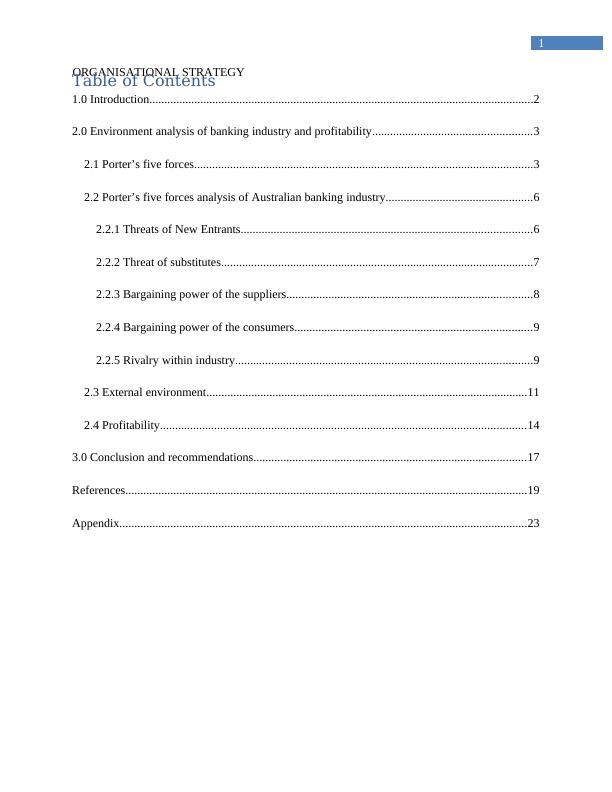
2
ORGANISATIONAL STRATEGY
1.0 Introduction
Banking industry of Australia is one of the largest sectors of the economy. The industry is
dominated by four major banks, namely, Commonwealth Bank of Australia (CBA), Australia
and New Zealand Banking Group (ANZ), National Australia Bank (NAB) and Westpac Banking
Corporation (Walton 2020). There are some other smaller and regional banks also throughout the
nation and various different types of financial institutions. All the commercial retail banking and
financial institutions are controlled and regulated by the central bank, that is, Reserve Bank of
Australia (RBA). In Australia, there are 53 banks, among which 14 are owned by the Australian
government. All the four primary banks of Australia had cash earnings of $26.9 billion in total in
2019, with a net interest margin of 1.94% (Dring 2019). Thus, it can be said that the banking and
finance industry of Australia has been a major contributor to the GDP over the decades and due
to RBA’s appropriate regulatory policies, Australia has managed to experience a record
continuous economic growth for more than two decades. It can also be inferred that similar to
any other industry, the banking sector has been facing certain challenges as well as opportunities
over the years, which have influenced the performances of the industry, whether positively or
negatively. To understand the challenges, opportunities, and competitive position of the banking
industry, Porter’s five forces analysis is performed in this report. The aim of the report is to
analyse the key variables within the external environment which have a direct impact on the
banking industry and macro-environmental variables that might influence the current and future
performance of the financial industry. It is important to understand the environmental variables
and their relative strengths as that would help the banking industry to design policies accordingly
and mitigate the effects of challenges for keeping the economy stable. Hence, a thorough
discussion has been made in this report to highlight different aspects of the Porter’s five forces
ORGANISATIONAL STRATEGY
1.0 Introduction
Banking industry of Australia is one of the largest sectors of the economy. The industry is
dominated by four major banks, namely, Commonwealth Bank of Australia (CBA), Australia
and New Zealand Banking Group (ANZ), National Australia Bank (NAB) and Westpac Banking
Corporation (Walton 2020). There are some other smaller and regional banks also throughout the
nation and various different types of financial institutions. All the commercial retail banking and
financial institutions are controlled and regulated by the central bank, that is, Reserve Bank of
Australia (RBA). In Australia, there are 53 banks, among which 14 are owned by the Australian
government. All the four primary banks of Australia had cash earnings of $26.9 billion in total in
2019, with a net interest margin of 1.94% (Dring 2019). Thus, it can be said that the banking and
finance industry of Australia has been a major contributor to the GDP over the decades and due
to RBA’s appropriate regulatory policies, Australia has managed to experience a record
continuous economic growth for more than two decades. It can also be inferred that similar to
any other industry, the banking sector has been facing certain challenges as well as opportunities
over the years, which have influenced the performances of the industry, whether positively or
negatively. To understand the challenges, opportunities, and competitive position of the banking
industry, Porter’s five forces analysis is performed in this report. The aim of the report is to
analyse the key variables within the external environment which have a direct impact on the
banking industry and macro-environmental variables that might influence the current and future
performance of the financial industry. It is important to understand the environmental variables
and their relative strengths as that would help the banking industry to design policies accordingly
and mitigate the effects of challenges for keeping the economy stable. Hence, a thorough
discussion has been made in this report to highlight different aspects of the Porter’s five forces

3
ORGANISATIONAL STRATEGY
model, supported by academic theories, for evaluating the competitive position of the Australian
banking industry within the economy.
2.0 Environment analysis of banking industry and profitability
2.1 Porter’s five forces
Porter’s five forces is a very effective tool to understand the competitiveness of the
environment of a business and also to identify the potential profitability of the business strategy
(Rothaermel 2016). The five forces are threat of new entrants, threat of substitutes, bargaining
power of customers, bargaining power of suppliers and rivalry among the existing competitors.
Through these forces, the macro-environmental factors of a business are assessed to identify their
relative influence on the business operations, attractiveness and profitability.
Threat of
Substitutes
Threat of
Substitutes
Threat of
New Entrants
Threat of
New Entrants
Bargaining Power
of Customers
Bargaining Power
of Customers
Bargaining Power
of Suppliers
Bargaining Power
of Suppliers
Rivalry Among
Existing
Competitors
Figure 1: Porter's five forces framework
(Source: Nurlansa and Jati 2016)
ORGANISATIONAL STRATEGY
model, supported by academic theories, for evaluating the competitive position of the Australian
banking industry within the economy.
2.0 Environment analysis of banking industry and profitability
2.1 Porter’s five forces
Porter’s five forces is a very effective tool to understand the competitiveness of the
environment of a business and also to identify the potential profitability of the business strategy
(Rothaermel 2016). The five forces are threat of new entrants, threat of substitutes, bargaining
power of customers, bargaining power of suppliers and rivalry among the existing competitors.
Through these forces, the macro-environmental factors of a business are assessed to identify their
relative influence on the business operations, attractiveness and profitability.
Threat of
Substitutes
Threat of
Substitutes
Threat of
New Entrants
Threat of
New Entrants
Bargaining Power
of Customers
Bargaining Power
of Customers
Bargaining Power
of Suppliers
Bargaining Power
of Suppliers
Rivalry Among
Existing
Competitors
Figure 1: Porter's five forces framework
(Source: Nurlansa and Jati 2016)
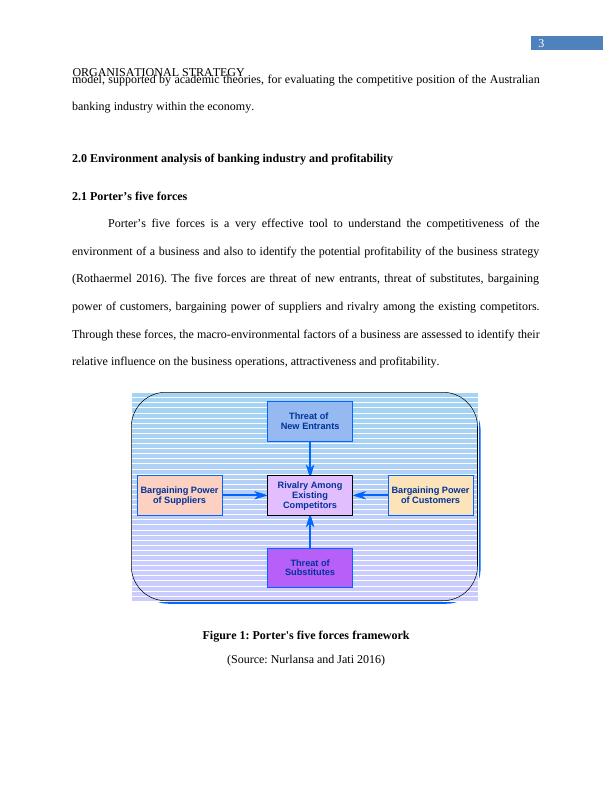
4
ORGANISATIONAL STRATEGY
As explained by Rothaermel (2016), there are many factors that influence these forces to
assess the competitiveness of the businesses, such as, the threat of new entrants is influenced
by economies of scale, proprietary product differences, brand identity, capital requirements,
access to distribution, absolute cost advantages, government policies, expected retaliation, and
switching costs of the customers. When a business has lower economies of scale, loses brand
identity, or has high requirement for funding, low switching cost, low absolute cost advantage or
loses distribution access, then the threat of new entrants becomes high and lowers its
competitiveness in the market.
Threat of substitutes implies the availability of substitute, that is, goods or services that
are similar and can satisfy the similar needs of the consumers. The influencing factors are
relative price and performance of the substitutes, switching costs and buyers’ propensity to
substitute the product or service of a particular industry (Nurlansa and Jati 2016). When the
threat of substitute is high for an industry, its competitiveness reduces.
Bargaining power of the suppliers indicates the convenience of the suppliers to increase
their prices. Number of suppliers, uniqueness of their supplies, the switching cost from one
supplier or firm to another, presence of the substitute inputs, concentration of the suppliers
relative to the industry suppliers, cost of production or operation relative to the total purchase in
the industry, impact of the supplies on production cost or differentiation, extent of information
about the supply, profitability of the suppliers, incentives of the decision makers and threat of
forward integration are the major elements that can give an edge to the suppliers and when the
industry is profitable when the bargaining power of the suppliers is low (Varelas and
Georgopoulos 2017).
ORGANISATIONAL STRATEGY
As explained by Rothaermel (2016), there are many factors that influence these forces to
assess the competitiveness of the businesses, such as, the threat of new entrants is influenced
by economies of scale, proprietary product differences, brand identity, capital requirements,
access to distribution, absolute cost advantages, government policies, expected retaliation, and
switching costs of the customers. When a business has lower economies of scale, loses brand
identity, or has high requirement for funding, low switching cost, low absolute cost advantage or
loses distribution access, then the threat of new entrants becomes high and lowers its
competitiveness in the market.
Threat of substitutes implies the availability of substitute, that is, goods or services that
are similar and can satisfy the similar needs of the consumers. The influencing factors are
relative price and performance of the substitutes, switching costs and buyers’ propensity to
substitute the product or service of a particular industry (Nurlansa and Jati 2016). When the
threat of substitute is high for an industry, its competitiveness reduces.
Bargaining power of the suppliers indicates the convenience of the suppliers to increase
their prices. Number of suppliers, uniqueness of their supplies, the switching cost from one
supplier or firm to another, presence of the substitute inputs, concentration of the suppliers
relative to the industry suppliers, cost of production or operation relative to the total purchase in
the industry, impact of the supplies on production cost or differentiation, extent of information
about the supply, profitability of the suppliers, incentives of the decision makers and threat of
forward integration are the major elements that can give an edge to the suppliers and when the
industry is profitable when the bargaining power of the suppliers is low (Varelas and
Georgopoulos 2017).
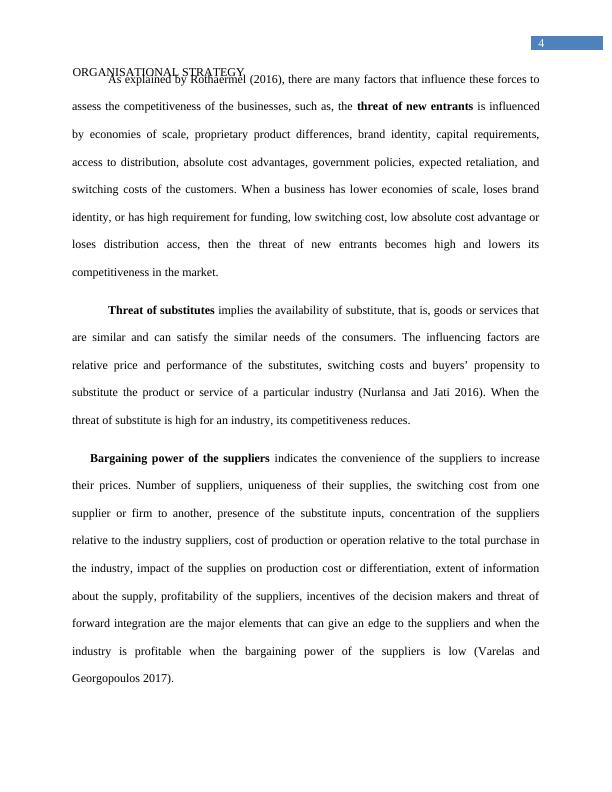
5
ORGANISATIONAL STRATEGY
Bargaining power of customers represents the influential power of the customers to
drive down the prices of the industry. The profitability of an industry or a business considerably
depends on the volume of customers and their preferences. The more the number of buyers, the
higher is the industry competiveness and profitability. As stated by Nurlansa and Jati (2016), the
important elements that should be considered while assessing the power of the customers are the
output differentiation, availability of substitutes, switching cost of the consumers, concentration
of industries relative to that for the buyers, cost of operation and production in relation to total
buyer purchase, consumers’ profitability, information to the buyers about industry output,
incentives of the decision makers, effect of the production on the cost or differentiation of the
buyers, and threats of the backward integration are the most important aspects that influence the
bargaining power of the customers and that affects the profitability of the industry.
Lastly, the rivalry among existing competitors represents the aspects like growth rate of
the industry, high fixed cost, brand image and identity, production potential or intermittent over-
capacity, product differentiation, informational complexity, corporate stakes, exit barriers,
balance and concentration and diversity of the competitors, which determine the attractiveness
and profitability of an industry (Varelas and Georgopoulos 2017). The more is internal rivalry,
the lower is the profitability of the industry. Thus, it can be said that, the profitability and
competitiveness of an industry depends on all the above factors and these aspects, combined with
the dynamic conditions, have changes in their nature and strength of influence on the industry
attractiveness.
ORGANISATIONAL STRATEGY
Bargaining power of customers represents the influential power of the customers to
drive down the prices of the industry. The profitability of an industry or a business considerably
depends on the volume of customers and their preferences. The more the number of buyers, the
higher is the industry competiveness and profitability. As stated by Nurlansa and Jati (2016), the
important elements that should be considered while assessing the power of the customers are the
output differentiation, availability of substitutes, switching cost of the consumers, concentration
of industries relative to that for the buyers, cost of operation and production in relation to total
buyer purchase, consumers’ profitability, information to the buyers about industry output,
incentives of the decision makers, effect of the production on the cost or differentiation of the
buyers, and threats of the backward integration are the most important aspects that influence the
bargaining power of the customers and that affects the profitability of the industry.
Lastly, the rivalry among existing competitors represents the aspects like growth rate of
the industry, high fixed cost, brand image and identity, production potential or intermittent over-
capacity, product differentiation, informational complexity, corporate stakes, exit barriers,
balance and concentration and diversity of the competitors, which determine the attractiveness
and profitability of an industry (Varelas and Georgopoulos 2017). The more is internal rivalry,
the lower is the profitability of the industry. Thus, it can be said that, the profitability and
competitiveness of an industry depends on all the above factors and these aspects, combined with
the dynamic conditions, have changes in their nature and strength of influence on the industry
attractiveness.
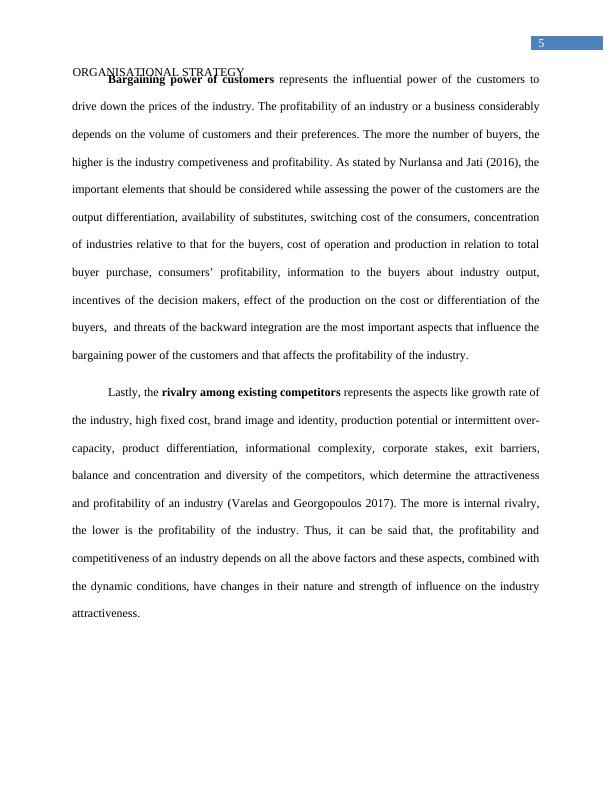
End of preview
Want to access all the pages? Upload your documents or become a member.
Related Documents
3112IBA Management Strategy and Decision Makinglg...
|5
|2037
|340
Financial Managementlg...
|16
|3147
|139
International & Global Business Assignmentlg...
|16
|4410
|61
Assessment of Profitability in Australian Automobile Industrylg...
|16
|4589
|22
Competitive Analysis of Australian Supermarket Industry through Porter’s Five Forces Modellg...
|5
|695
|429
Business Analysis and Valuationlg...
|16
|1291
|35
